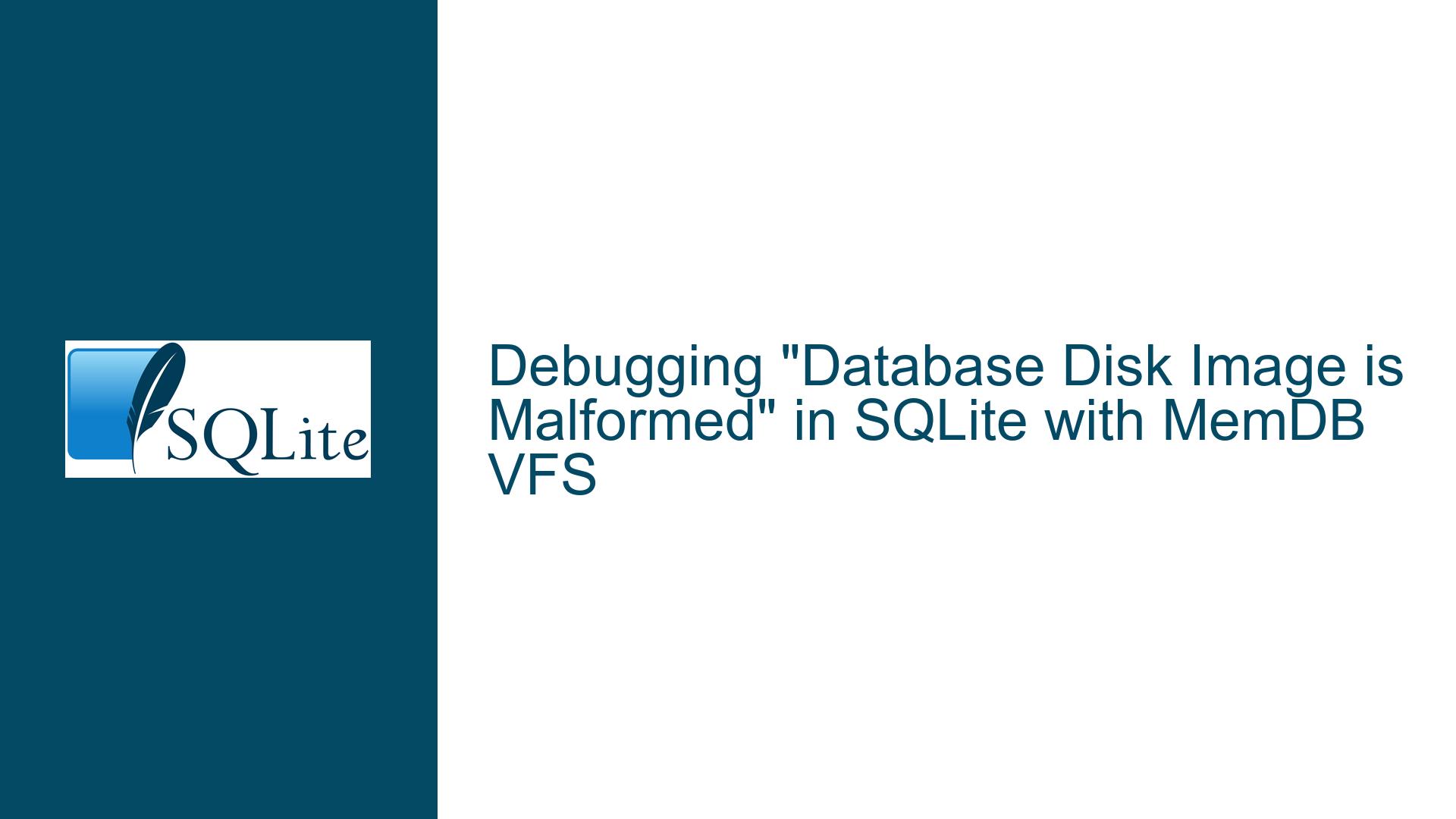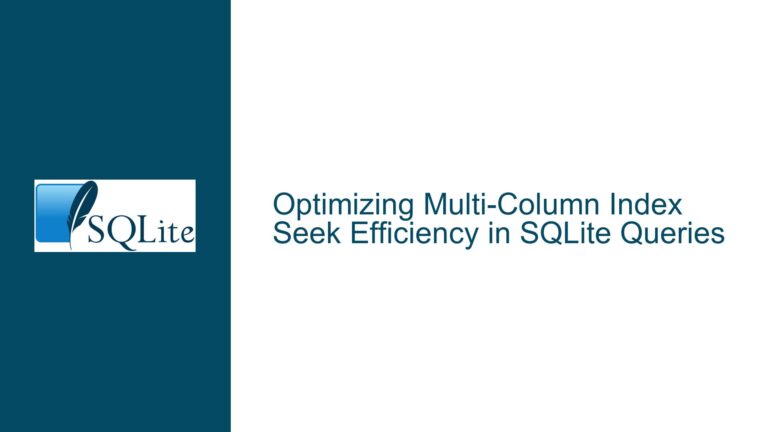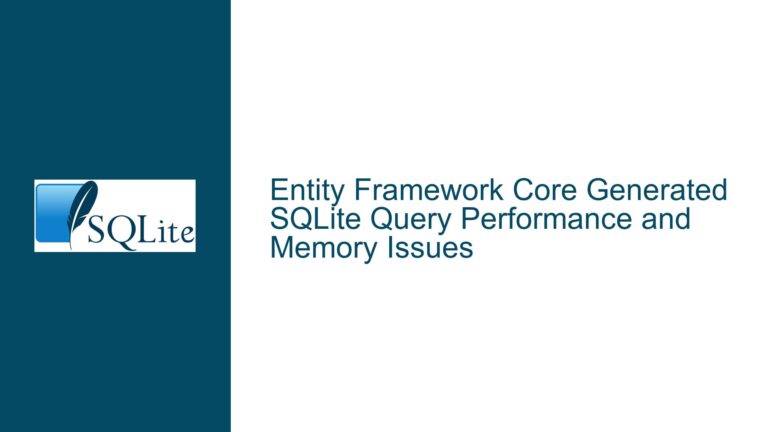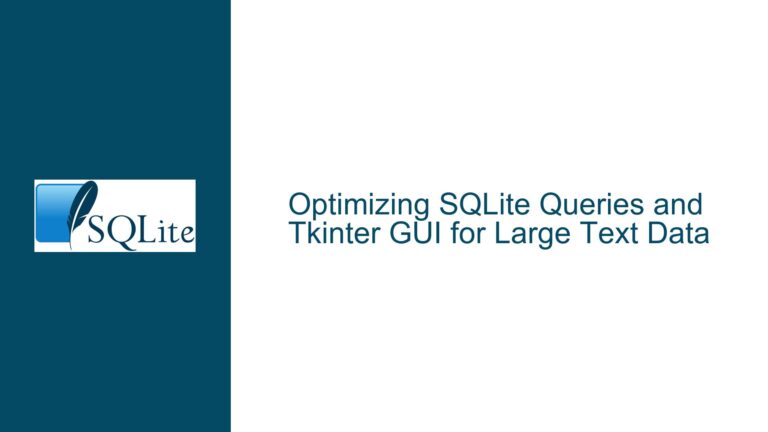Debugging “Database Disk Image is Malformed” in SQLite with MemDB VFS
Understanding the "Database Disk Image is Malformed" Error in SQLite with MemDB VFS
The "database disk image is malformed" error in SQLite is a critical issue that indicates the database file or image has become corrupted or is in an inconsistent state. This error is particularly perplexing when it occurs with an in-memory database (using the MemDB VFS), as there is no physical disk file involved. The error typically arises during operations such as sqlite3_step() when the database engine detects inconsistencies in the internal data structures or page formats. In the context of the provided discussion, the issue manifests when a high-rate insertion operation is performed on one thread while a concurrent SELECT COUNT query is executed on another thread. This scenario suggests a potential race condition or a flaw in the MemDB VFS implementation.
The MemDB VFS is a virtual file system designed for in-memory databases, which means it operates entirely within the application’s memory space. Unlike traditional disk-based databases, MemDB avoids I/O overhead, making it ideal for high-performance use cases. However, this also means that any corruption or inconsistency in the database image is likely due to logical errors in the VFS implementation or improper usage of the SQLite API. The error is particularly concerning because it implies that the database engine cannot reliably interpret its own data structures, which could lead to data loss or application crashes.
The error is not limited to a specific version of SQLite, as it has been reproduced across multiple versions, including SQLite 3.39.4 and 3.40.0. This suggests that the issue is not a regression but rather a latent bug that surfaces under specific conditions, such as high-concurrency workloads. The fact that the error occurs with both C and Go bindings further indicates that the problem lies in the core SQLite library or the MemDB VFS, rather than in the language-specific bindings.
Potential Causes of the "Database Disk Image is Malformed" Error
The "database disk image is malformed" error can stem from several root causes, particularly in the context of in-memory databases and high-concurrency workloads. Below are the most plausible explanations for this issue:
Race Conditions in MemDB VFS: The MemDB VFS is designed to handle concurrent access to an in-memory database. However, if the VFS implementation does not properly synchronize access to shared data structures, race conditions can occur. For example, if one thread is writing to the database while another thread is reading, the reader might encounter an inconsistent or partially updated state, leading to the "malformed" error. This is especially likely in high-rate insertion scenarios, where the database is frequently modified.
Improper Handling of SQLITE_BUSY: SQLite uses a locking mechanism to manage concurrent access to the database. When a thread attempts to read or write to the database while another thread holds a lock, SQLite returns the
SQLITE_BUSYstatus code. If the application does not handle this status code correctly, it can lead to undefined behavior, including database corruption. In the provided example, the program sets a long busy timeout but does not explicitly handleSQLITE_BUSYduring thesqlite3_step()call. This could result in the database engine attempting to proceed with an operation while the database is in an inconsistent state.Memory Management Issues: In-memory databases rely on dynamic memory allocation to store data structures. If the MemDB VFS or the SQLite engine has bugs in its memory management logic, such as buffer overflows, use-after-free errors, or incorrect pointer arithmetic, it could corrupt the database image. This corruption would manifest as a "malformed" error when the engine attempts to interpret the corrupted data.
Uninitialized or Misaligned Data Structures: SQLite relies on well-defined data structures to represent database pages, indices, and other internal components. If the MemDB VFS fails to properly initialize or align these structures, the database engine might misinterpret the data, leading to the "malformed" error. This could occur if the VFS implementation does not adhere to the memory alignment requirements of the underlying hardware or if it incorrectly handles padding and alignment.
Threading Mode Misconfiguration: SQLite supports multiple threading modes, including single-thread, multi-thread, and serialized. The serialized mode is the safest for concurrent access, as it ensures that all database operations are fully serialized and thread-safe. However, if the threading mode is misconfigured or if the application does not adhere to the threading considerations outlined in the SQLite documentation, it could lead to race conditions and database corruption.
Undefined Behavior in Application Code: The provided C program contains several code quality issues, such as an unused and leaked prepared statement, a missing return value in a function, and a lack of error handling for
SQLITE_BUSY. While these issues do not directly cause the "malformed" error, they contribute to undefined behavior, which can exacerbate existing bugs in the SQLite engine or the MemDB VFS. For example, the missing return value could lead to stack corruption, which might indirectly affect the database engine’s operation.
Troubleshooting Steps, Solutions, and Fixes for the "Database Disk Image is Malformed" Error
Resolving the "database disk image is malformed" error requires a systematic approach to identify and address the root cause. Below are detailed steps to troubleshoot and fix the issue:
Upgrade to the Latest SQLite Version: The discussion reveals that the issue has been fixed in the latest trunk version of SQLite. Upgrading to this version should resolve the problem if it is indeed caused by a bug in the MemDB VFS. Ensure that you are using the most recent stable release or a version that includes the fix (commit
15f0be8a640e7bfa).Enable Comprehensive Compiler Warnings: The provided C program contains several code quality issues that could contribute to undefined behavior. To catch these issues early, enable comprehensive compiler warnings using flags such as
-Wall,-Wextra, and-Werrorin GCC or-Weverythingin Clang. This will help identify problems such as missing return values, unused variables, and potential memory leaks.Handle SQLITE_BUSY Correctly: Ensure that your application properly handles the
SQLITE_BUSYstatus code. Whensqlite3_step()returnsSQLITE_BUSY, the application should either retry the operation after a short delay or abort the transaction. Setting a long busy timeout is not sufficient, as it does not eliminate the need to handleSQLITE_BUSY. Implement a retry mechanism with exponential backoff to avoid busy-waiting.Review and Refactor Application Code: Carefully review the application code for potential issues that could contribute to undefined behavior. For example, ensure that all functions return a value if they are declared to do so, and avoid leaking resources such as prepared statements. Use tools like Valgrind or AddressSanitizer to detect memory management issues such as buffer overflows and use-after-free errors.
Verify Threading Mode Configuration: Confirm that SQLite is running in the correct threading mode for your application. For high-concurrency workloads, the serialized mode is recommended, as it ensures thread safety by fully serializing database operations. Use the
sqlite3_threadsafe()function to verify the threading mode at runtime.Test with a Disk-Based Database: To isolate the issue, test the application with a disk-based database instead of an in-memory database. If the error does not occur with a disk-based database, the problem is likely specific to the MemDB VFS. This can help narrow down the root cause and guide further investigation.
Minimize Concurrency During Debugging: Temporarily reduce the level of concurrency in your application to see if the error persists. For example, limit the number of threads performing insertions or queries. If the error disappears, it suggests that the issue is related to race conditions or improper synchronization in the MemDB VFS.
Inspect SQLite Source Code and Debug Logs: If the issue persists, inspect the SQLite source code and enable debug logging to gather more information about the error. Look for any anomalies in the MemDB VFS implementation, such as improper synchronization or memory management issues. Use the
SQLITE_DEBUGcompile-time option to enable additional debugging features.Consult SQLite Documentation and Community: Refer to the SQLite documentation for guidance on threading considerations, error handling, and best practices for using the MemDB VFS. Engage with the SQLite community through forums or mailing lists to seek advice and share your findings. The community can provide valuable insights and help identify potential workarounds or fixes.
Implement Robust Error Handling and Recovery: Enhance your application’s error handling and recovery mechanisms to gracefully handle database errors. For example, if the "malformed" error occurs, the application should log the error, abort the current transaction, and attempt to reopen the database or switch to a backup database. This will help minimize the impact of the error on the application’s overall functionality.
By following these steps, you can systematically identify and resolve the root cause of the "database disk image is malformed" error. The key is to approach the issue methodically, leveraging tools, documentation, and community resources to ensure a robust and reliable solution.






